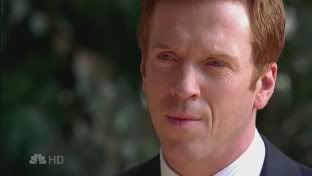Watching: Life
I need a serial mystery on TV. With the passing of Veronica Mars, I expected my appetite to be satisfied by Heroes or Dexter, but at this point it's the puzzle of what happened to Charlie Crews that is engaging me most. For those not watching Life, Charlie is the homicide detective picking up the pieces of his life after twelve years of brutal imprisonment for a crime he didn't commit. Although Charlie and his female partner tackle a murder each week, it is Charlie's search for those who framed him twelve years before that lifts this procedural into something far more interesting.

Rob Thomas talked about how tough it was to pace a season-long mystery to give out just the right amount of information without making Veronica look dumb for not following up on certain clues earlier than she did. In a clever move, the writers/producers of Life have withheld not just the "who-dun-it," but the details of the original crime and the reason why Charlie was wrongly convicted. In less skilled hands, we would no doubt have had a pilot explaining the crime. Instead, we are left to tease out the salient features as we can, whether through faux-documentary interviews, Charlie's wall of inquiry, or contemporary events that shed darkness on the parts played by those with unknown motives.
I'm missing VM and so far Life is no substitute in terms of my attachment to the characters, but this overarching mystery allows me some solace.
This is my summary so far as it seems too early for theorising. I'm sure I'm missing stuff: Charlie Crews, a police officer, was imprisoned in 1995 for the triple murder of Tom Seybolt, his wife and young son on or around January 28, 1994. It was reported that there were no eyewitnesses and that the Seybolt's nine-year-old daughter Rachel was out of the house on a sleepover. Photographs at the crime scene of the daughter's unmade bed suggest otherwise. Rachel has since disappeared, taking another name. Tom's body was found in the living room. His throat was slit. His wife was killed on the staircase. The boy was killed in his bedroom; his body found lying next to a blood-spattered soccer ball. There was no forced entry. A bloody kitchen knife, presumably the murder weapon, was logged as evidence on July 17, 1994. The evidence against Charlie was plentiful and he had a motive - boyhood friend Tom was skimming the profits of a bar they jointly owned. The jury took only an hour to judge him guilty.

Charlie's wife, Jennifer, did not believe Charlie's protestation of innocence in the light of the evidence and dumped divorce papers on him in the mail within the first year of his sentence. Three years later, she married Mark Conover. Charlie's father also cut him off and after Charlie was convicted, he prevented Charlie's mother from visiting Charlie, a course of action that Charlie believes led to his mother's death. While in prison, Charlie did something to a corrections officer that has not endeared him to prison guards.
A conspiracy website alleged Charlie was framed by at least three methods: a) necrotic timeline rigged for supposed blood evidence, b) alibi collusion, and c) force non-testimony of any/all police witnesses. After the case was re-opened, it was found that none of the physical evidence on the scene matched Charlie and he was exonerated twelve years later. The city settled a law suit brought by Charlie, the terms of which included allowing Charlie to continue his career in the police department, now as a homicide detective, as well as an undisclosed significant amount of money. Charlie is using his position to investigate the case for which he was wrongly convicted. This could be dangerous as Charlie's settlement and job are dependent on additional terms which prevent him from approaching key players.

Charlie keeps track of his investigation by means of the walls of an alcove in his dressing room on which he has placed photographs, notes, newspaper clippings, and maps. On Charlie's wall: a) a note to "follow the money," b) a note over a picture of a blood-spattered wall "compromised DNA," c) notes on the status of so far unidentified photographed subjects such as "dead in accident," "missing," "40k in wife's account," "reassigned," "sudden dismissal," and "sudden promotion." Many of the pictures are of police officers. Under a picture of his former partner, Bobby Stacks, with whom no one would ride for four years after the conviction and who purloined and kept Charlie's badge and gun while he was imprisoned, Charlie has written "he could not have seen." Against a picture of the lead detective on the case, Carl Ames (now retired, allegedly a man with a drinking problem towards the end of the original investigation, and still firmly convinced of Charlie's guilt), Charlie writes "removed Rachel from report." Next to a picture of Rachel Seybolt, he writes "did she see?"
Lt. Davis, the supervisor of Charlie and his new partner, Dani Reese, is keen for Dani, herself a past screw-up requiring drug rehabilitation, to find evidence to kick Charlie off of the force. Lt. Davis and Dani's father were partners for three years. Lt. Davis is of interest to Charlie in his investigation and he places a picture of her from her purloined personnel file on his wall. Bobby casually jokes about pocketing cash found at a crime scene.
Anybody else out there trying to work out this mystery?

Rob Thomas talked about how tough it was to pace a season-long mystery to give out just the right amount of information without making Veronica look dumb for not following up on certain clues earlier than she did. In a clever move, the writers/producers of Life have withheld not just the "who-dun-it," but the details of the original crime and the reason why Charlie was wrongly convicted. In less skilled hands, we would no doubt have had a pilot explaining the crime. Instead, we are left to tease out the salient features as we can, whether through faux-documentary interviews, Charlie's wall of inquiry, or contemporary events that shed darkness on the parts played by those with unknown motives.
I'm missing VM and so far Life is no substitute in terms of my attachment to the characters, but this overarching mystery allows me some solace.
This is my summary so far as it seems too early for theorising. I'm sure I'm missing stuff: Charlie Crews, a police officer, was imprisoned in 1995 for the triple murder of Tom Seybolt, his wife and young son on or around January 28, 1994. It was reported that there were no eyewitnesses and that the Seybolt's nine-year-old daughter Rachel was out of the house on a sleepover. Photographs at the crime scene of the daughter's unmade bed suggest otherwise. Rachel has since disappeared, taking another name. Tom's body was found in the living room. His throat was slit. His wife was killed on the staircase. The boy was killed in his bedroom; his body found lying next to a blood-spattered soccer ball. There was no forced entry. A bloody kitchen knife, presumably the murder weapon, was logged as evidence on July 17, 1994. The evidence against Charlie was plentiful and he had a motive - boyhood friend Tom was skimming the profits of a bar they jointly owned. The jury took only an hour to judge him guilty.

Charlie's wife, Jennifer, did not believe Charlie's protestation of innocence in the light of the evidence and dumped divorce papers on him in the mail within the first year of his sentence. Three years later, she married Mark Conover. Charlie's father also cut him off and after Charlie was convicted, he prevented Charlie's mother from visiting Charlie, a course of action that Charlie believes led to his mother's death. While in prison, Charlie did something to a corrections officer that has not endeared him to prison guards.
A conspiracy website alleged Charlie was framed by at least three methods: a) necrotic timeline rigged for supposed blood evidence, b) alibi collusion, and c) force non-testimony of any/all police witnesses. After the case was re-opened, it was found that none of the physical evidence on the scene matched Charlie and he was exonerated twelve years later. The city settled a law suit brought by Charlie, the terms of which included allowing Charlie to continue his career in the police department, now as a homicide detective, as well as an undisclosed significant amount of money. Charlie is using his position to investigate the case for which he was wrongly convicted. This could be dangerous as Charlie's settlement and job are dependent on additional terms which prevent him from approaching key players.

Charlie keeps track of his investigation by means of the walls of an alcove in his dressing room on which he has placed photographs, notes, newspaper clippings, and maps. On Charlie's wall: a) a note to "follow the money," b) a note over a picture of a blood-spattered wall "compromised DNA," c) notes on the status of so far unidentified photographed subjects such as "dead in accident," "missing," "40k in wife's account," "reassigned," "sudden dismissal," and "sudden promotion." Many of the pictures are of police officers. Under a picture of his former partner, Bobby Stacks, with whom no one would ride for four years after the conviction and who purloined and kept Charlie's badge and gun while he was imprisoned, Charlie has written "he could not have seen." Against a picture of the lead detective on the case, Carl Ames (now retired, allegedly a man with a drinking problem towards the end of the original investigation, and still firmly convinced of Charlie's guilt), Charlie writes "removed Rachel from report." Next to a picture of Rachel Seybolt, he writes "did she see?"
Lt. Davis, the supervisor of Charlie and his new partner, Dani Reese, is keen for Dani, herself a past screw-up requiring drug rehabilitation, to find evidence to kick Charlie off of the force. Lt. Davis and Dani's father were partners for three years. Lt. Davis is of interest to Charlie in his investigation and he places a picture of her from her purloined personnel file on his wall. Bobby casually jokes about pocketing cash found at a crime scene.
Anybody else out there trying to work out this mystery?